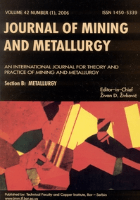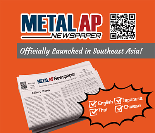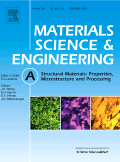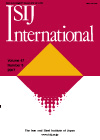
Journal of Mining and Metallurgy Section B-Metallurgy
Scope & Guideline
Innovating the future of mining and metallurgy.
Introduction
Aims and Scopes
- Hydrometallurgical Processes:
Research related to the hydrometallurgical extraction and processing of metals from ores, including innovative methods for improving recovery rates and reducing environmental impact. - Electrochemical Methods:
Studies involving electrochemical techniques for metal recovery, corrosion resistance, and surface treatments, emphasizing advancements in electrochemical technologies. - Thermodynamic Assessments:
Investigations that provide thermodynamic modeling and assessments of various metal systems, contributing to the understanding of phase equilibria and material properties. - Microstructural Analysis:
Research focused on the microstructural characterization of metallic materials, including the effects of processing techniques on material properties and performance. - Mechanical Properties and Performance:
Analysis of the mechanical behavior of metals and alloys, including studies on fatigue, wear, and corrosion resistance, aimed at enhancing material performance in industrial applications. - Recycling and Waste Utilization:
Exploration of methods for recycling metals and utilizing waste materials in metallurgical processes, contributing to sustainable practices in the mining and metallurgy sectors.
Trending and Emerging
- Rare Earth Element Recovery:
An increasing focus on the recovery of rare earth elements from various sources, including electronic waste and industrial byproducts, reflecting the growing demand for these critical materials. - Machine Learning Applications:
Emerging studies utilizing machine learning models for predictive analysis in metallurgy, such as predicting material properties and optimizing processing parameters. - Environmentally Friendly Processes:
A trend towards developing environmentally sustainable metallurgical processes, including the use of alternative reagents and recycling methods to minimize ecological impact. - Advanced Coatings and Surface Treatments:
Rising interest in the development of advanced coatings and surface treatments to enhance the properties of metals, particularly in terms of corrosion resistance and wear performance. - Nanocomposite Materials:
Research on the synthesis and application of nanocomposite materials in metallurgy, highlighting their potential to improve mechanical properties and functionality in various applications.
Declining or Waning
- Traditional Metallurgical Processes:
Research focusing on conventional metallurgical processes such as basic smelting techniques has decreased, possibly due to the industry's shift towards more sustainable and innovative methods. - Low-temperature Processing Techniques:
There has been a noticeable reduction in studies related to low-temperature metallurgical processing methods, as newer high-temperature techniques gain more attention for efficiency and effectiveness. - Basic Alloy Systems:
Investigations on basic alloy systems without advanced modifications or applications have waned, as researchers increasingly focus on high-performance alloys and composite materials. - Historical Metallurgy Studies:
Papers centered on historical metallurgy practices and their analyses are less prevalent, likely due to a growing emphasis on contemporary applications and technological advancements.
Similar Journals

TRANSACTIONS OF THE INDIAN INSTITUTE OF METALS
Unveiling new horizons in metal science.TRANSACTIONS OF THE INDIAN INSTITUTE OF METALS is a premier journal published by Springer India, dedicated to the field of metallurgy and materials science. Established in 1969, this journal serves as a vital platform for researchers and professionals to disseminate their findings on metals and alloys, showcasing innovative studies and experimental techniques. With an impressive impact factor and categorized in the Q2 quartile for metals and alloys as of 2023, it ranks 70 out of 176 in its field according to Scopus, placing it in the 60th percentile. The journal maintains a robust reputation for fostering academic excellence, thus attracting contributions from both established and emerging scholars. Though not an open access publication, its well-curated content remains a crucial resource for advancing knowledge and technology in metallurgy. The journal's extensive operational history, particularly during notable converged years, underscores its enduring significance in the scientific community.

METALURGIJA
Pioneering insights in materials chemistry and engineering.METALURGIJA is a distinguished open-access journal published by the Croatian Metallurgical Society, dedicated to advancing the field of metallurgical sciences and engineering. With an ISSN of 0543-5846 and E-ISSN of 1334-2576, this journal has been serving the academic community since its inception, offering valuable insights into condensed matter physics, materials chemistry, mechanics of materials, and metals and alloys. As of 2023, it ranks in Q3 in the fields of condensed matter physics, materials chemistry, and mechanics of materials, and Q2 in metals and alloys, reflecting its engagement with contemporary research and emerging trends. The journal's open-access policy, in place since 2002, ensures that high-quality research is accessible to a global audience, fostering collaboration and knowledge sharing. Located in Zagreb, Croatia, METALURGIJA aims to bring together researchers, industry professionals, and students alike to contribute to systemic advancements in metallurgical research and applications, ultimately enhancing innovation within the materials science community.

Korean Journal of Metals and Materials
Connecting Researchers in the World of Metals and MaterialsWelcome to the Korean Journal of Metals and Materials, a premier publication dedicated to advancing research in the interdisciplinary fields of metals and materials science. Published by the Korean Institute of Metals and Materials, this journal aims to foster the dissemination of innovative findings and significant developments across various domains, including electronic, optical, and magnetic materials, metals and alloys, as well as modeling, simulation, and surface coatings. With a commendable Q3 quartile ranking in several relevant categories as of 2023, it serves as a vital resource for researchers, professionals, and students interested in the latest scientific trends and technological applications. The journal has successfully converged from 2007 to 2024, showcasing a rich archive of knowledge. Engaging with this publication gives readers the opportunity to stay updated with critical advancements and enhances collaboration within the vibrant materials science community. Access is available through various platforms, ensuring that our content is widely accessible to all those striving for excellence in the field.

China Foundry
Advancing the Frontiers of Materials ScienceChina Foundry is a prestigious journal published by SPRINGER SINGAPORE PTE LTD, specializing in the fields of materials chemistry and metals and alloys. With an impact factor that showcases its reputable standing, this journal is categorized within the Q2 quartile for both Materials Chemistry and Metals and Alloys as of 2023. As an Open Access journal since 2004, it ensures that cutting-edge research is readily available to a global audience, promoting knowledge dissemination among researchers, professionals, and students alike. With a rich history converging from 2008 to 2024, China Foundry serves as a critical resource for the latest advancements and innovations in foundry technology, materials processing, and related fields. The journal's commitment to excellence is also reflected in its Scopus ranks, positioning it favorably within the competitive landscape of materials science. By fostering academic discourse and collaboration, China Foundry is an essential platform for those looking to contribute to and engage with the fast-evolving world of materials science.

ACTA METALLURGICA SINICA
Forging Connections Between Research and ApplicationACTA METALLURGICA SINICA, established in 1978 and published by SCIENCE PRESS, stands as a preeminent journal in the fields of metallurgy and materials science. This journal is particularly revered for its contributions to Metals and Alloys, Mechanical Engineering, Geotechnical Engineering, and Mechanics of Materials, with a commendable Q1 ranking in Metals and Alloys and notable placements in other engineering disciplines. With a robust history of facilitating scholarly communication from 1978 to 1991 and consistently since 1996, the journal provides a vital platform for researchers and practitioners to disseminate significant advancements in material science. Despite being a subscription-based journal, ACTA METALLURGICA SINICA remains pivotal, holding a Scopus ranking that places it in the top tiers of its categories, fostering an environment ripe for innovation and collaboration. This ensures that the journal remains central to the ongoing discussions and developments within the metallurgy community, serving both academic and professional interests.

METALLURGIA ITALIANA
Unveiling the Science of Materials EngineeringMETALLURGIA ITALIANA, an esteemed journal published by the ASSOCIAZIONE ITALIANA METALLURGIA, specializes in the fields of condensed matter physics, mechanics of materials, and metals and alloys. With a history spanning from 1969 to 2024, this Italian journal has consistently contributed to the scholarly conversation surrounding metallurgical sciences and materials engineering. Despite its Q4 ranking in several categories, the journal provides a critical platform for emerging research and advancements in metallurgy, encouraging interdisciplinary dialogue among academics, professionals, and students. Readers can benefit from valuable insights into the latest developments and applications in the field, supported by the journal's commitment to fostering academic rigor and innovation. While access options currently do not include open access, METALLURGIA ITALIANA remains a cherished resource for those dedicated to exploring the nuances of material properties and applications.

RUSSIAN METALLURGY
Pioneering Research in Metallurgy Since 1984RUSSIAN METALLURGY is a distinguished journal published by PLEIADES PUBLISHING INC, focusing on the fields of metals and alloys. With an ISSN of 0036-0295 and an E-ISSN of 1555-6255, this journal serves as a vital resource for researchers and practitioners alike, offering insights into the latest advancements and innovative research within the metallurgy domain. Recognized in a competitive landscape, it holds a Q3 ranking in the Metals and Alloys category as of 2023, reflecting its commitment to rigorous scientific dissemination. The journal spans a significant historical timeline of research since its inception in 1984, with aims to advance the knowledge and application of metallurgical science. Although currently not open access, it remains crucial for those aiming to stay current in the dynamic field of materials science. RUSSIAN METALLURGY fosters a deeper understanding of the physical and chemical properties of metals, guiding future innovations in industry and academia.

Protection of Metals and Physical Chemistry of Surfaces
Pioneering Research for Enhanced Material DurabilityProtection of Metals and Physical Chemistry of Surfaces is a prominent academic journal published by MAIK NAUKA/INTERPERIODICA/SPRINGER, which provides a specialized platform for researchers and professionals in the fields of materials chemistry, metals and alloys, organic chemistry, as well as surfaces, coatings, and films. With an ISSN of 2070-2051 and an E-ISSN of 2070-206X, the journal is recognized for its rigorous peer-reviewed content and comprehensive coverage of innovative research addressing the latest advancements in material protection and surface chemistry. As of 2023, the journal has been categorized in the Q3 quartile across several relevant fields, highlighting its increasing influence within the scientific community. Although the journal is relatively niche, its open access model encourages wide dissemination of knowledge, fostering collaboration and advancements within its core disciplines. Research published in this journal plays a crucial role in not only enhancing theoretical understanding but also facilitating practical applications in various industries, thereby underlining its importance for students, researchers, and professionals alike.

MATERIALS SCIENCE AND ENGINEERING A-STRUCTURAL MATERIALS PROPERTIES MICROSTRUCTURE AND PROCESSING
Advancing the Frontiers of Materials ScienceMATERIALS SCIENCE AND ENGINEERING A-STRUCTURAL MATERIALS PROPERTIES MICROSTRUCTURE AND PROCESSING, published by ELSEVIER SCIENCE SA, is a highly regarded journal specializing in the fundamental and applied aspects of materials science. Since its inception in 1988, this journal has established itself as a leading platform for disseminating innovative research findings, particularly focused on structural materials, their properties, microstructure, and processing techniques. With a prominent impact in the field, it ranks in the Q1 category across several disciplines including Condensed Matter Physics, Materials Science, Mechanical Engineering, and Nanoscience and Nanotechnology, highlighting its significance and influence within the academic community. The journal is accessible to a global audience of researchers, professionals, and students, underscoring its commitment to advancing knowledge in materials engineering. Aspiring authors and readers will find this journal an essential resource for cutting-edge research and the latest advancements in the field, further supported by its impressive Scopus rankings that place it among the top-tier publications.

ISIJ INTERNATIONAL
Connecting Scholars to Pioneering Discoveries in EngineeringISIJ INTERNATIONAL is a distinguished open-access journal in the fields of Materials Chemistry, Mechanical Engineering, Mechanics of Materials, and Metals and Alloys, published by the esteemed IRON STEEL INST JAPAN KEIDANREN KAIKAN. Since its inception in 1986, ISIJ INTERNATIONAL has played a pivotal role in disseminating advanced research and critical findings in steel and iron industries, significantly contributing to innovations in materials science and engineering. With a commendable impact factor and categorized in Q2 quartiles across its relevant fields in 2023, the journal ranks favorably among other prestigious publications, evidencing its influence and relevance within the academic community. The journal promotes open access, allowing unrestricted online access to its published work since 2012, thus ensuring that researchers, professionals, and students can readily access cutting-edge research. The journal's comprehensive scope empowers researchers to connect over pioneering studies and methodologies that address contemporary challenges in materials and engineering domains, thereby fostering a rich dialogue and knowledge exchange.